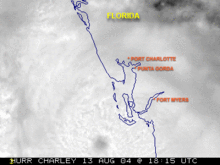Type a search term to find related articles by LIMS subject matter experts gathered from the most trusted and dynamic collaboration tools in the laboratory informatics industry.
Port Charlotte, Florida | |
|---|---|
 Location in Charlotte County and the state of Florida | |
| Coordinates: 26°59′25″N 82°6′21″W / 26.99028°N 82.10583°W | |
| Country | |
| State | |
| County | Charlotte |
| Area | |
| 32.34 sq mi (83.76 km2) | |
| • Land | 28.48 sq mi (73.76 km2) |
| • Water | 3.86 sq mi (9.99 km2) |
| Elevation | 7 ft (2 m) |
| Population (2020) | |
| 60,625 | |
| • Density | 2,128.69/sq mi (821.88/km2) |
| • Urban (Port Charlotte–North Port, FL) | 199,998 (US: 194th)[2] |
| • Urban density | 1,484.8/sq mi (573.3/km2) |
| • Metro | 194,843 (US: 229th) |
| Time zone | UTC−5 (Eastern (EST)) |
| • Summer (DST) | UTC−4 (EDT) |
| ZIP codes | 33900-33999 |
| Area code | 941 |
| FIPS code | 12-58350[3] |
| GNIS feature ID | 0289233[4] |
 | |
Port Charlotte is a census-designated place and unincorporated community in Charlotte County, Florida, United States. The population was 60,625 at the 2020 census, up from 54,392 at the 2010 census. It is part of the Punta Gorda, Florida Metropolitan Statistical Area, included in the North Port-Bradenton, Florida Combined Statistical Area.
Port Charlotte was named to the "10 Best Places to Retire", in the United States for the year 2012 by U.S. News & World Report.[5]
The Calusa originally settled around the Port Charlotte area.[6] In 1819, Florida was ceded by the Spanish and became a U.S. territory, and in 1845 Florida became the 27th state. For the first 100 years of statehood, the area around Port Charlotte was mostly undeveloped. Maps of the area at the turn of the 20th century show that most of the roads and railroads leading into southwest Florida had bypassed the Port Charlotte area.[7][8] Aside from some cattle ranches and small farming, the area was mostly uninhabited. This would change when the post-World War II boom opened people's eyes to the possibility of developing land in Florida.

In the 1950s, the now defunct General Development Corporation led by the Mackle brothers decided to take advantage of the Florida land boom and developed land primarily on both of Florida's coastlines. Among the areas they planned and developed was the Port Charlotte area. Ultimately, Port Charlotte became the most populous community in Charlotte County, although like most GDC developments, Port Charlotte remained an unincorporated community.
Port Charlotte was severely impacted by Hurricane Charley on August 13, 2004. The hurricane, predicted to hit Tampa as a Category 2 hurricane, took a last-minute right hand turn and intensified into a Category 4 storm as it made landfall near Charlotte Harbor and caused severe damage in the city of Punta Gorda and in the Port Charlotte area.[9] The storm's 145 miles per hour (233 km/h) maximum sustained winds destroyed almost half of the homes in the county and caused heavy ecological damage to sensitive wetlands in the area.[9][10]
Just over 18 years later, Port Charlotte was once again severely impacted by a major hurricane, this time Hurricane Ian on September 28, 2022. Ian made landfall as a Category 4 storm in Cayo Costa State Park before moving north-east into Charlotte Harbor, with south-eastern Port Charlotte going through the eye of the storm.[11] Ian caused severe damage to Port Charlotte, mostly wind-related, and to the rest of the surrounding area.[12] Maximum sustained winds of 115 miles per hour (185 km/h) and a wind gust of 132 miles per hour (212 km/h) were reported by a private weather station in Port Charlotte.[13]

Port Charlotte is located at the north end of the Charlotte Harbor Estuary, northwest of the city of Punta Gorda. It is 100 miles (160 km) south of Tampa and 65 miles (105 km) north of Naples. According to the United States Census Bureau, the CDP has a total area of 32.3 square miles (83.7 km2), of which 28.4 square miles (73.6 km2) is land and 3.9 square miles (10.1 km2) (12.01%), is water.[14]
Port Charlotte has a warm humid subtropical climate (Köppen climate classification: Cfa) bordering on a tropical wet and dry climate (Köppen climate classification: Aw).[15] The summers are long, hot and humid with frequent afternoon thunderstorms. The winters are mild to warm with a pronounced drop in precipitation. Year round, the diurnal temperature change averages around 20 degrees Fahrenheit (11 degrees Celsius).
| Climate data for Port Charlotte, Florida | |||||||||||||
|---|---|---|---|---|---|---|---|---|---|---|---|---|---|
| Month | Jan | Feb | Mar | Apr | May | Jun | Jul | Aug | Sep | Oct | Nov | Dec | Year |
| Record high °F (°C) | 89 (32) |
92 (33) |
93 (34) |
94 (34) |
98 (37) |
102 (39) |
99 (37) |
99 (37) |
95 (35) |
94 (34) |
93 (34) |
89 (32) |
102 (39) |
| Mean daily maximum °F (°C) | 75 (24) |
77 (25) |
80 (27) |
84 (29) |
89 (32) |
92 (33) |
92 (33) |
92 (33) |
91 (33) |
87 (31) |
81 (27) |
76 (24) |
85 (29) |
| Mean daily minimum °F (°C) | 52 (11) |
54 (12) |
57 (14) |
61 (16) |
66 (19) |
72 (22) |
74 (23) |
74 (23) |
73 (23) |
67 (19) |
60 (16) |
54 (12) |
64 (18) |
| Record low °F (°C) | 23 (−5) |
27 (−3) |
29 (−2) |
38 (3) |
49 (9) |
57 (14) |
63 (17) |
65 (18) |
61 (16) |
45 (7) |
28 (−2) |
25 (−4) |
23 (−5) |
| Average precipitation inches (mm) | 2.21 (56) |
2.31 (59) |
2.71 (69) |
1.70 (43) |
3.15 (80) |
8.45 (215) |
7.78 (198) |
7.82 (199) |
6.75 (171) |
3.12 (79) |
1.87 (47) |
1.77 (45) |
49.64 (1,261) |
| Source: The Weather Channel[16] | |||||||||||||
| Climate data for Port Charlotte | |||||||||||||
|---|---|---|---|---|---|---|---|---|---|---|---|---|---|
| Month | Jan | Feb | Mar | Apr | May | Jun | Jul | Aug | Sep | Oct | Nov | Dec | Year |
| Mean daily daylight hours | 10.5 | 11.0 | 12.0 | 13.0 | 13.5 | 14.0 | 13.5 | 13.0 | 12.5 | 11.5 | 11.0 | 10.5 | 12.2 |
| Source: Weather Atlas [17] | |||||||||||||
The area of northwestern Port Charlotte where State Road 776 intersects US 41 is also known as Murdock.
Since Port Charlotte is unincorporated, it is governed by the Charlotte County Board of County Commissioners. The county is governed by a 5-person county commission. They take turns rotating into the commission chair position every year. County commissioners frequently sit on other regional boards involving other municipalities and counties.
| Census | Pop. | Note | %± |
|---|---|---|---|
| 1960 | 3,197 | — | |
| 1970 | 10,789 | 237.5% | |
| 1980 | 25,770 | 138.9% | |
| 1990 | 41,535 | 61.2% | |
| 2000 | 46,451 | 11.8% | |
| 2010 | 54,392 | 17.1% | |
| 2020 | 60,625 | 11.5% | |
| source:[18] | |||
| Race | Pop 2010[19] | Pop 2020[20] | % 2010 | % 2020 |
|---|---|---|---|---|
| White (NH) | 42,903 | 44,474 | 78.88% | 73.36% |
| Black or African American (NH) | 4,753 | 4,847 | 8.74% | 8.00% |
| Native American or Alaska Native (NH) | 130 | 129 | 0.24% | 0.21% |
| Asian (NH) | 838 | 1,140 | 1.54% | 1.88% |
| Pacific Islander or Native Hawaiian (NH) | 26 | 33 | 0.05% | 0.05% |
| Some other race (NH) | 86 | 333 | 0.16% | 0.55% |
| Two or more races/Multiracial (NH) | 943 | 2,660 | 1.73% | 4.39% |
| Hispanic or Latino (any race) | 4,713 | 7,009 | 8.66% | 11.56% |
| Total | 54,392 | 60,625 | 100.00% | 100.00% |
As of the 2020 United States census, there were 60,625 people, 25,925 households, and 16,077 families residing in the CDP.[21]
According to Sperling's Best Places, as of July 2015 the family median income in Port Charlotte was $48,911, and household income was $40,049. The per capita income was $22,681. Port Charlotte's unemployment rate was 5.50%, compared to 6.30% for the United States overall.
As of the 2010 United States census, there were 54,392 people, 24,501 households, and 15,658 families residing in the CDP.[22]
As of the census[3] of 2000, there were 46,451 people, 20,453 households, and 13,601 families residing in the CDP. The population density was 2,085.9/sq mi (805.3/km2). There were 23,315 housing units at an average density of 1,047.0 per square mile (404.2/km2). The racial makeup of the CDP was 89.23% White, 6.53% African American, 0.28% Native American, 1.14% Asian, 0.05% Pacific Islander, 1.18% from other races, and 1.59% from two or more races. Hispanic or Latino of any race were 5.16% of the population.
In 2000, there were 20,453 households, out of which 20.8% had children under the age of 18 living with them, 53.2% were married couples living together, 10.1% had a female householder with no husband present, and 33.5% were non-families. 28.2% of all households were made up of individuals, and 18.6% had someone living alone who was 65 years of age or older. The average household size was 2.25 and the average family size was 2.71.
In 2000, in the CDP, the age distribution of the population shows 18.7% under the age of 18, 5.4% from 18 to 24, 21.0% from 25 to 44, 24.2% from 45 to 64, and 30.7% who were 65 years of age or older. The median age was 49 years. For every 100 females, there were 87.7 males. For every 100 females age 18 and over, there were 84.2 males.
Port Charlotte was home to the Charlotte Stone Crabs, which is a member of the Florida State League and Class High-A affiliate of the Tampa Bay Rays, which also hold its spring training at Charlotte Sports Park until 2020.[23] The Rays also hold extended spring training in Port Charlotte, and have a Florida Complex League team which began to play in June 2009.
The Port Charlotte Invitational was a golf tournament held in 1969 at the Port Charlotte Golf & Country Club on the LPGA Tour.[24] Kathy Whitworth won the event.

Public schools in Port Charlotte are operated by Charlotte County Public Schools.[25] For the 2007-08 school year, all schools in Port Charlotte received A's from the Florida Department of Education.[26] Port Charlotte High School is the only traditional public high school located in Port Charlotte, although some parts of Port Charlotte are considered part of Charlotte High School's area, and students have the option to attend Charlotte Virtual School, a charter school, a special needs school, or a different traditional public high school through school choice.[27] There are numerous private schools in Port Charlotte,[28] including Family Christian Academy (formerly known as Community Christian School),[29] Charlotte Preparatory School (formerly known as Charlotte Academy),[30] Genesis Christian School,[31] Joyful Noise Learning Center, Port Charlotte Adventist School,[32] Port Charlotte Christian School, and St. Charles Borromeo Catholic School.[33] Port Charlotte is home to three small higher education facilities, including Charlotte Technical College,[34] Southern Technical College's Port Charlotte campus,[35] and Southwest Florida Bible Institute.[36]
The Mid-County Regional Library and the Port Charlotte Library are located in Port Charlotte. They are included in the Charlotte County Library System.